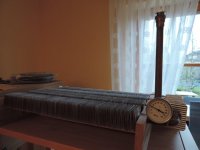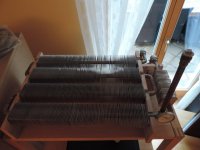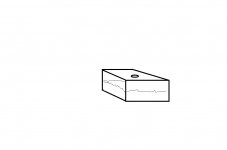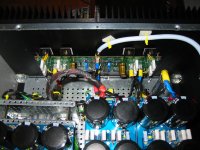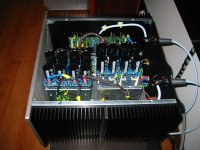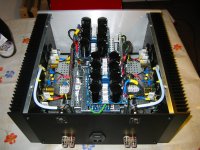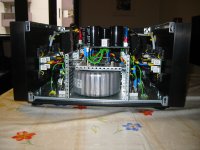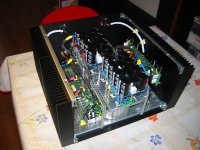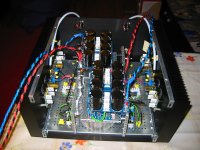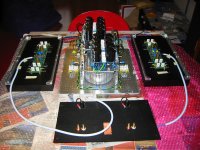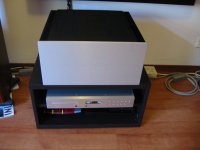Someone enjoys plugging holes.
...and sometimes it´s a pleasure too!
Very interesting James. Glad to see another member's approach to alternate cooling. Is the gauge for temp, flow or pressure? What's the function of the tall copper tube on top? I assume it's a fill port but it appears more sophisticated.
I think you are saying you believe not having a fan and/or pump is an advantage. I am using both to simply reduce the mass of the entire system. Did you try smaller tube/hose and still maintain adequate coolant flow?
Bob, your pictures impressed me and at the end you encouraged me to post.
The gauge is for temp.
The vertical tube is the fill port and acts as a buffer reservoir. When the system heats up the fluid expands a little.
My first setup used a pump and smaller hoses, but I dont liked the noise of the pump.
On the gravity feed system I did not try smaller hoses because the driving force of the system is the weight (density) difference of the liquid in both hoses. The most important thing is the available heat transfer surface inside the heat exchange block, since the flow speed is very low and you will see only laminar flow inside the system. With a pump you have higher speed and turbulant flow which gives better heat transfer.
So the basic idea using liqud cooling was to bring the gain devices closer together and shorten length of the lead traces on the PCB.
Attachments
Convective flow? Wonderful!
Neat speakers also...
Thank You!
Yes, convective flow, absolutely noiseless!
it's called thermosiphon flow
Yes, in german we call it: Thermosiphon.
Thanks, Getting silence from the fans and pump is indeed a challenge. I'm on my third pump style and still not completely satisfied. The design I'm working on now with 24 output devices can easily boil water and mess up the pump. I'm working on auto control of system shutdown to prevent that, but your design clearly avoids that glitch completely. Can you post some temp details?
One suggestion if I may - consider determining the expansion in the upper tube and build a tank that accommodates the change. That would allow a lower profile case if you intend to do something similar to what you did for the amp and PS units.
Very nice design. Thanks for sharing.
One suggestion if I may - consider determining the expansion in the upper tube and build a tank that accommodates the change. That would allow a lower profile case if you intend to do something similar to what you did for the amp and PS units.
Very nice design. Thanks for sharing.
Attachments
Wow.. 24x 30W =>720W ..not bad!
So in any case you need a lot of air over the fins to carry away this amount of energy. Instead of the fans maybe you should think about something like a chimney.
My Alpeh-X dissipates about 300W (2,25A Bias at 17V per MOSFET, x8).
MOSFET-Cases are 60°C.
coolant out: 42°C
coolant in: 35°C
This temperatures are sommer or winter almost the same. I think this is because the system increase the flow by itself in case of higher ambient.
The System contains about 1,5 Liter coolant (I use same as in the car, for corrosion protection issues).
Heat up takes 30 Minutes, Soundstage expands already after 20 Minutes.
Regarding the expansion tank and case:
In the beginning I thought about this too, but never found time to do it... My wife asks from time to time also, when it will be finished...
So in any case you need a lot of air over the fins to carry away this amount of energy. Instead of the fans maybe you should think about something like a chimney.
My Alpeh-X dissipates about 300W (2,25A Bias at 17V per MOSFET, x8).
MOSFET-Cases are 60°C.
coolant out: 42°C
coolant in: 35°C
This temperatures are sommer or winter almost the same. I think this is because the system increase the flow by itself in case of higher ambient.
The System contains about 1,5 Liter coolant (I use same as in the car, for corrosion protection issues).
Heat up takes 30 Minutes, Soundstage expands already after 20 Minutes.
Regarding the expansion tank and case:
In the beginning I thought about this too, but never found time to do it... My wife asks from time to time also, when it will be finished...
I have built this about 6 years ago according Grey Rollins schematic, and it´s still in use:
The coolant circulates only by gravity. (without a pump)
Minor point.....would that be "by gravity", or by convective flow due to the delta T of the water?
The difference in density of the hotter coolant cf. the cooler coolant creates a pressure difference. That pressure difference promotes the flow.
It's the same when an open fire heats the air in a chimney. The chimney draws cooler air into the open fire and vents the hotter air out of the near vertical stack.
The critical part is the requirement for a near vertical stack of warmer coolant. That is what promotes the flow.
It's the same when an open fire heats the air in a chimney. The chimney draws cooler air into the open fire and vents the hotter air out of the near vertical stack.
The critical part is the requirement for a near vertical stack of warmer coolant. That is what promotes the flow.
The difference in density of the hotter coolant cf. the cooler coolant creates a pressure difference. That pressure difference promotes the flow.
It's the same when an open fire heats the air in a chimney. The chimney draws cooler air into the open fire and vents the hotter air out of the near vertical stack.
The critical part is the requirement for a near vertical stack of warmer coolant. That is what promotes the flow.
Yep.... I used to live in a house with a fireplace chimney that was four stories high. When I opened the flue damper, I'd get a RIVER of cold air streaming down the chimney. Fixed the problem, by "priming" the chimney with a small 120 VAC heat gun (think "very strong hair dryer"). Problem solved, once I got the thermal rise in the chimney...and it was a log better than getting a room of smoke.....!
Minor point.....would that be "by gravity", or by convective flow due to the delta T of the water?
Andrew explained it well.
Higher delta T, gives more pressure difference, and higher flow rate.
So it fits well to class A amps: everything has to be big.
F5Turbo-X build
I have finally completed my F5Turbo-X build. Special thanks to Nelson Pass and all forum members supporting and inspiring DIYes out there!
-- xLoff
I have finally completed my F5Turbo-X build. Special thanks to Nelson Pass and all forum members supporting and inspiring DIYes out there!
-- xLoff
Attachments
Hi ZM and emyeuoi,
Thanks for the feedback.
- This was the original plan, but I was afraid the amp wold be too heavy at the front, possibly tipping over with ~70% of its 25 kilos at the front... I did follow your tip about hiding the AC mains leads though (link).
- Hi bcmbob. It's an Audiolab 8200 CDQ preamp with DAC (ESS 9018) and optional CD drive. One of the few decent preamp - DAC combos with analog inputs I could find.
-- xLoff
Thanks for the feedback.
next time - put those Donuts one on top of the other , and you'll have place for cap banks , also put one on top of the other
or - using big additional plate , you can put both Donuts right behind front plate , "vertically"
- This was the original plan, but I was afraid the amp wold be too heavy at the front, possibly tipping over with ~70% of its 25 kilos at the front... I did follow your tip about hiding the AC mains leads though (link).
Xloff, That last picture prompts me to ask what you are using for volume control. Does what looks like a CD player have that function? I could easily be reading more into that shot than you intended
- Hi bcmbob. It's an Audiolab 8200 CDQ preamp with DAC (ESS 9018) and optional CD drive. One of the few decent preamp - DAC combos with analog inputs I could find.
-- xLoff
A power amp doesn't need a volume control. That function is normally performed by the pre-amp.
Quite correct, but a playback system usually does.
xLoff - Very nice combo unit. I have about the same functionality in what happens before the F5/BA-3 but spread across several boxes. As stated in the linked review, the sound shaping and control options are virtually endless - particularly with the 8200 PC union.
Very nice system indeed

I have finally completed my F5Turbo-X build. Special thanks to Nelson Pass and all forum members supporting and inspiring DIYes out there!
-- xLoff
Thank you for sharing the pictures.
Very nice built!
Please be so kind to share also some key specs (Trafo VA, I-Bias, Rail-V, Offset-V, Type of Mosfets, ...).
- Home
- Amplifiers
- Pass Labs
- Pictures of your diy Pass amplifier
